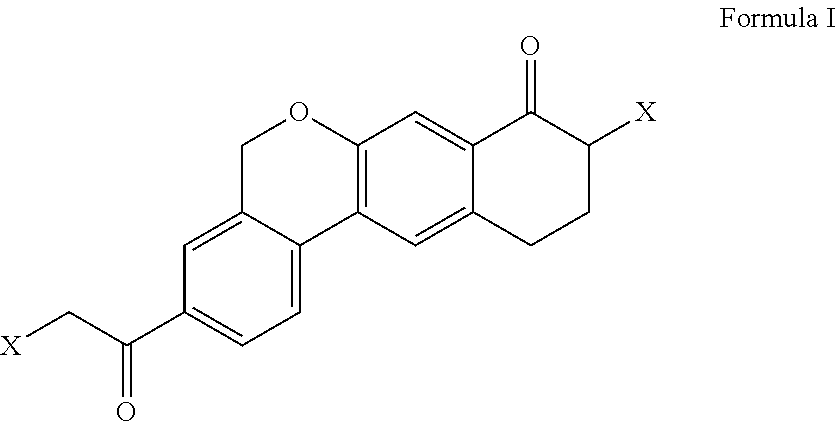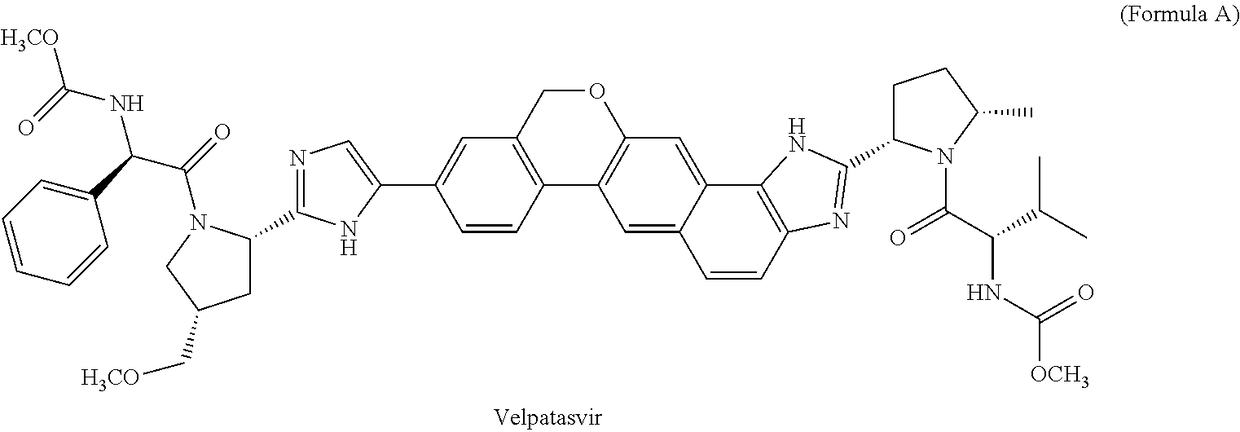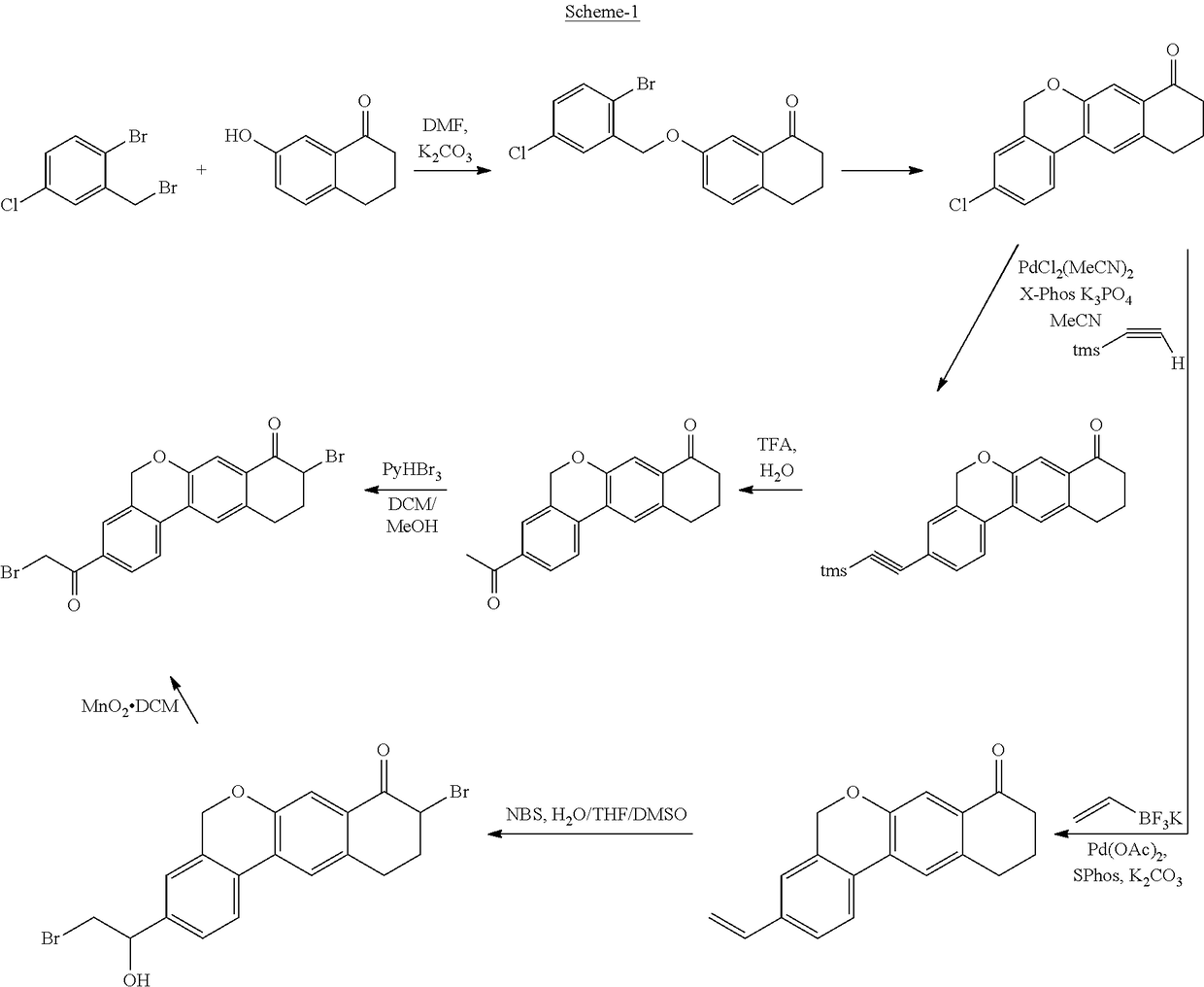Process for the preparation of intermediates useful in the preparation of hepatitis c virus (HCV) inhibitors
a technology of hepatitis c virus and intermediates, applied in the field of process for the preparation of 9halo3(2haloacetyl)10, 11dihydro5hdibenzoc, gchromen8 (9h)one, can solve the problem of not being viable on cost effective commercial scale operations
- Summary
- Abstract
- Description
- Claims
- Application Information
AI Technical Summary
Benefits of technology
Problems solved by technology
Method used
Image
Examples
example 1
Preparation of 4-bromo-3-(bromomethyl)-benzonitrile
[0073]4-bromo-3-methylbenzonitrile (80 g), 1,3-dibromo-5,5-dimethylhydantoin (70 g), azobisisobutyronitrile (6.7 g), and ethylene chloride (650 mL) were combined in a 1-L reaction flask. Then the reaction mixture was heated to 80-85° C. and stirred for 19 hr at the same temperature. The reaction mixture was allowed to cool to 20-25° C. and washed with saturated aqueous sodium bicarbonate solution (650 mL) followed by water (650 mL). The organic layer was separated and concentrated to a dark brown oil, which solidified upon standing. The resulting solid was stirred in a mixture of methyl tert-butyl ether (40 mL) and heptane (80 mL) for 3 hr. The resulting slurry was filtered and the filter cake was washed with heptane (80 mL). The filter cake was dried in a vacuum oven at 35° C. to obtain the title compound. Yield: 51.3 g; HPLC purity: 95.1%; 1H NMR (300 MHz, CDCl3) δ 7.73 (d, 1H, J=2.0 Hz), 7.70 (d, 1H, J=8.3 Hz), 7.42 (dd, 1H, J=8....
example 2
Preparation of 4-bromo-3-(bromomethyl)-benzonitrile
[0074]4-bromo-3-methylbenzonitrile (9.8 g), 1,3-dibromo-5,5-dimethylhydantoin (7 g), and 1,2-dichloroethane (80 mL) were combined in a 1-L reaction flask and stirred under nitrogen at 10-15° C. To the reaction mass 2,2′-azobis (2-methypropionitrile) (0.82 g) was added and the reaction mixture was heated to 80-85° C. After completion of the reaction, the reaction mixture was filtered to remove 5,5-dimethylhydantoin (4.2 g). The mother liquor was used in the next step without further purification (Yield: 12 g wt / wt assay).
example 3
Preparation of 7-(2-bromo-5-cyanobenzyloxy)-3,4-dihydronaphthalen-1 (2H)-one
[0075]7-hydroxy-1-tetralone (26 g) and potassium carbonate (44 g) in N,N-dimethylacetamide (130 mL) were combined in a 1-L reaction flask. To the reaction mass a dimethylacetamide solution of 4-bromo-3-(bromomethyl)benzonitrile (44 g in 130 mL) was added at 25-30° C. The resultant reaction mixture was stirred at ambient temperature for 68 hr. To the reaction mixture water (520 mL) was added at 8-12° C. over 25 min and stirred for 30 min at 10° C. The precipitated solid was filtered, and to the solid, water (300 mL) was added and stirred for 45 min. The solid was filtered and washed with water (50 mL) and dried at 35° C. under vacuum for about 24 hr to obtain the title compound. Yield: 58.7 g; HPLC purity: 98.2%; 1H NMR (300 MHz, CDCl3) δ 7.85 (m, 1H), 7.71 (d, 1H, J=8.2 Hz), 7.58 (d, 1H, J=2.7 Hz), 7.46 (dd, 11H, J=8.2, 2.0 Hz), 7.23 (d, 1H, J=10.4 Hz), 7.16 (dd, 11H, J=8.4, 2.7 Hz), 5.13 (s, 2H), 2.93 (dd, ...
PUM
| Property | Measurement | Unit |
|---|---|---|
| temperature | aaaaa | aaaaa |
| temperature | aaaaa | aaaaa |
| temperature | aaaaa | aaaaa |
Abstract
Description
Claims
Application Information
 Login to View More
Login to View More - R&D
- Intellectual Property
- Life Sciences
- Materials
- Tech Scout
- Unparalleled Data Quality
- Higher Quality Content
- 60% Fewer Hallucinations
Browse by: Latest US Patents, China's latest patents, Technical Efficacy Thesaurus, Application Domain, Technology Topic, Popular Technical Reports.
© 2025 PatSnap. All rights reserved.Legal|Privacy policy|Modern Slavery Act Transparency Statement|Sitemap|About US| Contact US: help@patsnap.com



